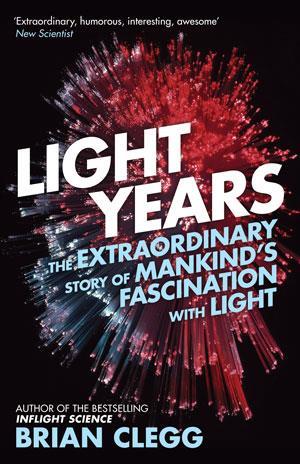Brian Clegg
Icon Books Ltd
2015 | 336pp | £8.99
ISBN 9781848318144

Have you ever wondered at what distance the human eye is capable of perceiving a single candle? Or considered how the apparent brightness of the full moon compares to that of the Sun? Maybe you’d like to know what Newton would have had to say about that dress – would he have been on team ‘blue and black’ or ‘white and gold’? If any of these questions pique your interest, this may be the book for you, but there’s far more to Light years than just dinner table trivia.
In what is an extremely readable popular science book, Brian Clegg details the history of mankind’s understanding of light. The narrative style flows easily as it covers a 2500 year period and a vast array of characters, weaving from Mo-Tzu’s discovery of the camera obscura in 500 BC to the emergence of advanced technologies like ‘slow glass’ and faster-than-light transmissions, which feel like science fiction but may soon be a reality. Many of the contributions from history’s most famous scientists are discussed alongside a wealth of lesser-known names. Clegg’s work also avoids historical snobbery and he is happy to spend time clearly explaining crucial missteps, as well as key breakthroughs, in the progression of our scientific understanding.
The breadth of material covered in this comprehensive study of light, coupled with the presence of often whimsical anecdotes, means that even those who come to the text with an academic interest are likely to find something new. All of the more esoteric ideas are explained clearly with the aid of diagrams by Clegg, who has laboured to ensure that the main text of Light years is accessible to all.
While the book is not rigorously footnoted, there is ample provision for readers who want to delve deeper. There are three pages of further reading suggestions and, perhaps unusually for popular science books, a number of references appended to Clegg’s narrative, which influenced its development.
Light years was first written in 2001 and subsequently revised in 2008. The revision does not discuss any research that has occurred after the initial publication, so it is possible there are books available on a similar subject which are more current. What this book provides, though, is a comprehensive history of light, which should appeal to the academic and layman alike. If at the book’s end you find you are compelled to seek out information about more recent developments, then this is to Clegg’s credit.
Purchase Light years: the extraordinary story of mankind’s fasincation with light from Amazon.co.uk












No comments yet